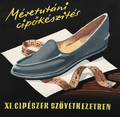
Description:
“But, he thought, I keep them with precision. Only I have no luck anymore. But who knows? Maybe today. Every day is a new day. It is better to be lucky. But I would rather be exact. Then when luck comes you are ready.”
(Ernest Hemingway, The Old Man and the Sea)
This book cover design maquette was created in 1965, for a Hungarian edition of ‘The Old Man and the Sea’. “The Old Man and the Sea is a short novel written by the American author Ernest Hemingway in 1951 in Bimini, Bahamas, and published in 1952. It was the last major work of fiction by Hemingway that was published during his lifetime. One of his most famous works, it tells the story of Santiago, an aging Cuban fisherman who struggles with a giant marlin far out in the Gulf Stream off the coast of Florida.
In 1953, The Old Man and the Sea was awarded the Pulitzer Prize for Fiction, and it was cited by the Nobel Committee as contributing to their awarding of the Nobel Prize in Literature to Hemingway in 1954.”
(wikipedia.org)
The painted book cover design is a spectacular piece. It shows a concentrated painted composition with an abstract character. In front of a deep green, patched background, a long, crisscross white line appears artistically painted with a sudden move. At the top it is connected to a triangular-shaped part painted with fast brushwork. The whole motif represents the skeleton of the fish with the head on, as the story tells in the end, and the background reminds of the depth of the sea. The title appears on the left side in red and white painted font.
The creator of the artwork was Iván Váradi. There is hardly any information about the artist, but observing his available works, we can come to several conclusions. In the second part of the 1950s he used stiff elements and his designs had a simplified, but expressive character. During the 1960s his works were likely to have an artistic, expressionist style, and he was influenced by even minimalist, cartoon-like, or abstract tendencies, among other ones. This modality was in harmony with the poster art of the decade as a bigger artistic freedom came true for designers and illustrators then.
Here Váradi chose an abstract form to express the atmosphere of the book. The piece is a good example for the ability of expressiveness of the artist. With one well-chosen and spontaneous gesture he could perfectly represent the skeleton. This artwork shows the use of the graphical inventory of the internationally present abstract expressionist tendencies of the post-war period with its loose brushwork, dripping, staining and other expressive painterly gestures.











